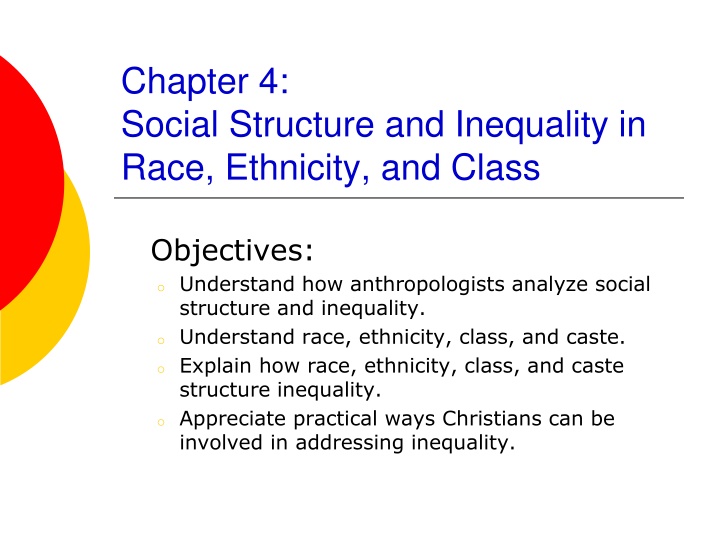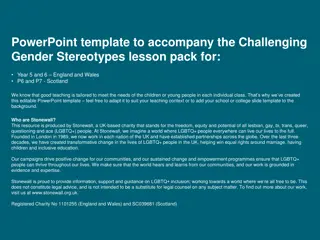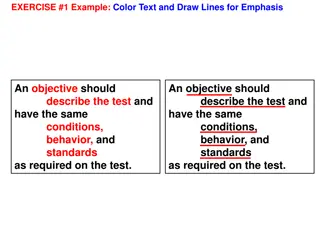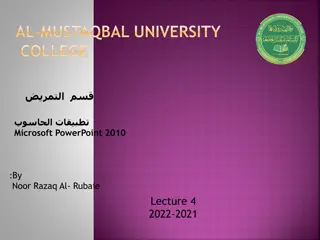
Social Structure and Inequality in Race, Ethnicity, and Class
Explore the analysis of social structure and inequality by anthropologists, diving into race, ethnicity, class, and caste. Learn how these factors shape inequality and discover practical ways for Christians to address social disparities.
Download Presentation

Please find below an Image/Link to download the presentation.
The content on the website is provided AS IS for your information and personal use only. It may not be sold, licensed, or shared on other websites without obtaining consent from the author. If you encounter any issues during the download, it is possible that the publisher has removed the file from their server.
You are allowed to download the files provided on this website for personal or commercial use, subject to the condition that they are used lawfully. All files are the property of their respective owners.
The content on the website is provided AS IS for your information and personal use only. It may not be sold, licensed, or shared on other websites without obtaining consent from the author.
E N D
Presentation Transcript
Chapter 4: Social Structure and Inequality in Race, Ethnicity, and Class Objectives: o Understand how anthropologists analyze social structure and inequality. o Understand race, ethnicity, class, and caste. o Explain how race, ethnicity, class, and caste structure inequality. o Appreciate practical ways Christians can be involved in addressing inequality.
Areas of Social Stratification Power Prestige Wealth
Social Structure and Inequality Social Structure The ways people coordinate their lives in relation to one another at the level of society. Social Inequality The differential access to economic resources, political power, or social prestige that results from social stratification.
Social Structure and Inequality Status Any position a person must occupy in a social structure. Types: Achieved Ascribed
Social Structure and Inequality Role A prescribed set of behaviors for those who occupy a particular status.
Race A cultural category that divides humanity into subgroups based on particular phenotypical (appearance) differences.
Race The Creation of Racial Categories: European settlers kept those of African descent under control by creating racial difference. Scientists encoded race into the neutral and objective language of science. Race categories vary dramatically across societies.
Race Race and Inequality: People use racial categories to explain (or justify) social inequality. Today race correlates with social problems such as poverty, unemployment, violence, and imprisonment. Some racial groups have developed their own cultural traditions because of historic segregation.
Ethnicity A category based on the sense of group affiliation derived from a distinct heritage or worldview as a people.
Ethnicity (continued) The Creation of Ethnic Categories Anthropologists note that ethnic identities always have political and economic dimensions.
Ethnicity (continued) The Creation of Ethnic Categories 1. Primordialism is the view that ethnic identity is a naturally occurring and immutable feature of human life. 2. Instrumentalism describes how ethnicity changes with people s interests and context.
Ethnicity (continued) Ethnicity and Inequality Some see ethnicity as fairly unimportant for social organization; others find it very important. New ethnic categories may emerge for political or social reasons. Ethnicity can be used to exclude some people from access to resources or power.
Class and Caste Class A cultural category describing how people are grouped according to their positions within the economy. Caste A tightly bounded social group based on family background. Caste systems assign individuals to a position at birth, and mobility between castes is restricted.
Culture and Class Class identity May be less about having money than about having the opportunity to learn the class culture. Class mobility Some societies may not have a connection between class mobility and the equitable distribution of resources.
Christian Responses to Inequality I have heard numerous southern religious leaders admonish their worshipers to comply with a desegregation decision because it is the law, but I have longed to hear white ministers declare: Follow this decree because integration is morally right and because the Negro is your brother. In the midst of blatant injustices inflicted upon the Negro, I have watched white churchmen stand on the sideline and mouth pious irrelevancies and sanctimonious trivialities. In the midst of a mighty struggle to rid our nation of racial and economic injustice, I have heard many ministers say: Those are social issues, with which the gospel has no real concern. And I have watched many churches commit themselves to a completely other-worldly religion which makes a strange, un-Biblical distinction between body and soul, between the sacred and the secular. -Martin Luther King Jr., Letter from Birmingham Jail
Christian Responses to Inequality What would Jesus have the church do in the face of widespread inequality, economic injustice, or racism?
Discussion Questions 1. Consider the society you live in right now. How open and flexible is the social class system? (In other words, if a person wanted to move from a lower class to a higher class, how easy or difficult might it be for them?)
Discussion Questions 1. (continued) On a scale of 1 to 10, t meaning totally open class system, and 10 meaning totally rigid class system, rate your society s degree of social mobility. Do students in your class rate your society in different ways? What sources of information lead them to different conclusions? What are some credible sources of information that could sharpen the accuracy of your perceptions?
Discussion Questions 2. What is your ethnicity? What is your face? Is one of these easier to define than the other? Why might that be? 3. Identify an area of role conflict and an area of role strain in your life. How does the anthropological perspective, seeing individual experience linked to social structure, shape how you might address these problems in your life?






















